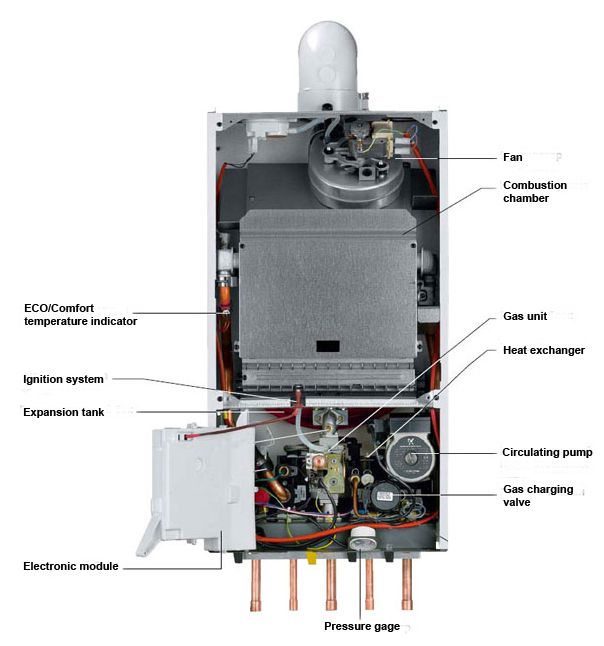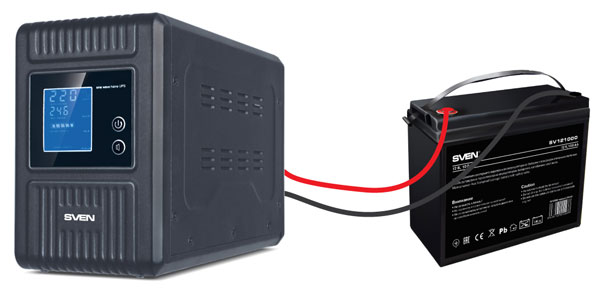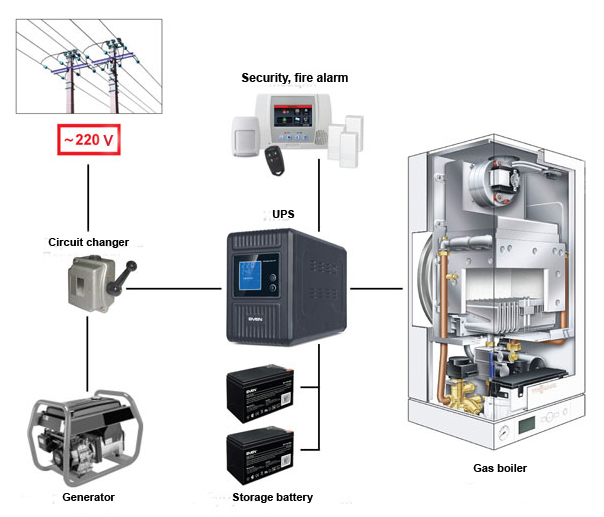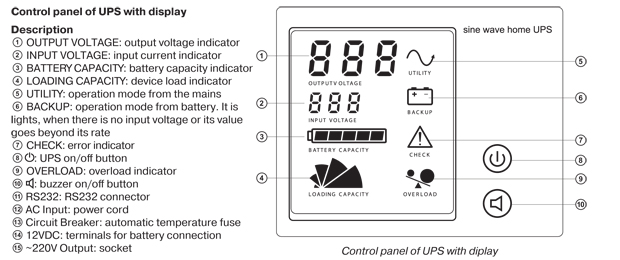It is no secret that AC power supply networks in use are far from the ideal. Most often a reason of failures of electronic devices is the off-grade power supply. Partially this problem can be solved at the cost of using devices for the improvement of power supply quality, such, for example, as automatic voltage regulators.
At the same time cases of miss or complete absence of electric power are not infrequent. In this case there is a necessity to provide the power supply to especially vital systems, such as heating, communication, security and fire alarm systems. To avoid failures in their operation, it is worthwhile to organize uninterrupted power supply systems consisting of an uninterrupted power supply source (UPS) and storage batteries.
An uninterrupted power supply system is intended to provide electric power to the electrical equipment connected to it including the voltage absence in the power supply network. The automatic voltage regulator built in UPS will provide qualitative power supply when there is low or high voltage in the network, as well as it will protect the connected devices or appliances against disturbances and voltage jumps in the network.
So in order to protect the equipment properly against problems with power supply, it is necessary to select correctly an uninterrupted power supply system (i.e. UPS and batteries), which will correspond to the protected equipment.
1. SELECTION OF AN UNINTERRUPTED POWER SUPPLY
Three main types of uninterrupted power supplies –Off-Line UPS, On-Line UPS and line-interactive UPS (Line-Interactive) are the most widespread uninterrupted power supplies.
Uninterrupted power supplies of Off-Line type
In the normal operation mode of Off-Line UPS, the power is supplied with the filtered voltage of the primary network. But when input voltage parameters go beyond the values of a preset range, a device is switched to the battery operation mode, irrespective of whether there is voltage in the network or not. This imposes certain limits on such devices:
- Off-Line UPS are applicable only in networks with stable quality of electric energy;
- their shortcoming is the bad protection against voltage depressions and exceeding its admissible values, changes of frequency and input voltage forms, as well as impossibility to renew capacity of storage batteries timely during frequent switching to the battery operation;
- due to the great voltage spread in the network, especially outside big cities, the full-fledged use of Off-Line UPS maybe only jointly with an additional automatic voltage regulator.
Uninterrupted power supplies of On-Line type
In the normal operation mode of On-Line UPS (they are also named as UPS of double transformation) the network voltage is rectified and then it is transformed into direct voltage for a battery charging and power supply to the output stage.
When the network voltage is sufficient the output stage transforms direct voltage into sinusoidal voltage 220 V. When the network voltage is lower the current shortage is compensated by a battery, but if the voltage is absent, the power is supplied from the battery only.
Power supply quality and operation reliability of such a device are significantly higher in comparison with the previous type. But this device has shortcomings all the same:
- low coefficient of efficiency as compared with other UPS types because of double transformation;
- high cost;
- relatively small battery resource.
Such UPS are mostly used to maintain the operation of servers and routers in corporate networks.
Uninterrupted power supplies of Line-Interactive type
Line-interactive UPS combine advantages and, as well as it may be possible, minimize shortcomings of uninterrupted power supplies of Off-Line and On-Line types.
In the first place, the built-in automatic voltage regulator of such UPS provides qualitative power supply when the network voltage is high or low, as well as it protects equipment against interferences and network voltage jumps.
In the second place, when the input voltage parameters are beyond the operating range, as well as the voltage is absent for a short or a long time, the power is supplied from a battery (batteries), which provides the power supply continuity.
The nonzero switching time (4-10 ms) to batteries is a shortcoming of line-interactive UPS, but in most cases it is not critical for consumers.
UPS of Line-Interactive type is subdivided into:
- UPS with the output approximated sinusoid (it suits only for devices with pulse power units);
- more unified UPS with the regular shape sinusoid, which can operate with devices critical to the form of input current (with transformers, motors, compressors, etc.).
UPS of Line-Interactive type is the most optimal choice for the uninterrupted power supply system, based on the price, consumer properties, coefficient of efficiency and resource (resources) of battery (batteries).
Selection of an uninterrupted power supply system for a modern gas boiler
The power supply problem becomes especially acute in winter. It depends on the load increase to the network and unfavorable weather conditions, which frequently result in short-time and long-term interruptions in the power supply network.
The autonomous heating system based on a gas boiler becomes one of the most vulnerable systems in these conditions. Wide spread occurrence of such heating systems is caused by comparatively low cost of gas, their reliability and efficiency, but at the same time they depend on the power supply. Power difference and failures lead to the gas boiler stopping and this can cause its damage, and even the heating system can be out of order.
In order to understand to some extent what is this equipment, let us consider the operation of a gas boiler of relatively simple construction.

Gas boiler construction |
Force circulation of a heat-transfer agent in modern heating systems is supported with the help of electric circulation pumps. Some modifications of boilers have air boost systems into a combustion chamber and removal of products of combustion on the basis of electric fans, as well as microprocessor control units.
A thermostat controls the air temperature in an apartment. When temperature drops, “Heating” mode is switched on a circular pump starts to operate, pumping the heat-transfer agent through the heating network. Then a gas valve is opened and the burner is ignited. Energy due to gas combustion heats the heat-transfer agent in the heat exchanger. A manometer and thermometer control the heat-transfer agent indices. The operation of the whole device is controlled by the electronic control unit.
The correctly selected uninterrupted power supply system (UPS + battery) will enable to avoid problems related to the boiler stop or its out of order due to voltage differentials, as well as it provides its operation within the time required.
When selecting an uninterrupted power supply for the boiler it is necessary to take into account that the output voltage form of UPS must be sinusoidal, because the boiler contains devices-consumers critical to the input current form (fan, circulating pump, gas valve, electronic unit).
We recommend following the next criteria when selecting UPS for a modern gas boiler to avoid a mistake:
- Power consumption in modern boilers is small. It ranges as a rule within limits from 80 to 300 W. Select UPS with small power allowance.
- Autonomous operation time, during which UPS must provide the load. In order the boiler operates for the required period of time in the absence of power supply in the network, it is necessary to buy UPS with a possibility to connect external blocks of batteries. Depending on required autonomous operation time, the necessary capacity of battery is selected. Pay also attention to the protection of batteries against overdischarging. When batteries are overdischarged (below permissible level), their capacity decreases quickly, that leads to the operation time reduction.
- Built-in automatic voltage regulator. ЕIf there are great voltage fluctuations in the power network, then the input voltage range of AVR is an important characteristic for the UPS choice: the wider the range, the rarer UPS will be switched to the battery operation and this will increase the battery life time. It is better to select UPS with a built-in AVR.
UPS of RESERVE HOME series developed and produced by SVEN Company is an ideal solution for the uninterrupted power supply of heating systems, intellectual fire-fighting and alarm systems, automation systems, etc.

ИБП SVEN Reserve Home-1000 with SVEN SV121000 battery |
A correct outlet sine signal enables to provide the uninterrupted power supply of consumers, which are critical to the current supply form.
Continuous backup power supply is realized due to considerable, changeable in wide limits capacity of external batteries.
The built-in automatic voltage regulator makes it possible to provide the correct power supply, when the network voltage is low or high without switching to the battery operation mode. This enables to save the battery (batteries) resource considerably.
UPS of such a construction controls continuously the power network parameters, corrects automatically power supply voltage or switches to battery (batteries) operation, providing continuous operation of equipment.
In order to select an UPS Reserve Home model, calculate the total power (W) of equipment connected to UPS (it is given in technical documentation of equipment).
Select UPS Reserve Home model (Reserve Home-500, Reserve Home-800 or Reserve Home-1000) depending on the power from Table 1.
 |
2. SELECTION OF BATTERIES
In order to select a battery (batteries), it is necessary to select from Table 2 the total capacity of a battery (batteries) base on the load power and approximate autonomous operation time. On the basis of the selected capacity, choose a particular battery (batteries):
 |
The autonomous operation time given in Table 2, which was made on the basis of experimental data, is provided during joint operation with batteries of SVEN Company SVEN SV12500 (capacity with 20-hour discharge – 50 A•h) and SVEN SV121000 (capacity with 20-hour discharge – 100 A•h).

Structural diagram of uninterrupted power supply network |
The uninterrupted power supply set consisting of UPS models of SVEN Reserve Home and SVEN batteries of SV series has been developed in such a way that its assembling and connection to the protected equipment does not cause difficulties for users, who do not have special training.
3. CONNECTION AND OPERATION
1. Place the set (SVEN Reserve Home UPS + SVEN batteries) in a site chosen by you with good ventilation (free space around UPS must be not less than 25 cm).
2. Connect SVEN battery (purchased separately) to UPS power terminals observing a polarity using supplied cables. Pay attention, in case of using several batteries, connect the batteries IN PARALLEL, observing a polarity. Let us remind that a positive terminal is always red, but a negative terminal is black or blue. While connecting two or more batteries, a positive terminal of one battery is connected to a positive terminal of the other, negative terminals of batteries are connected in a like manner. Additional cables (purchased separately) will be required to connect additional batteries.
3. Connect SVEN Reserve Home to a socket of the single-phase network (desirably with grounding) using the built-in power cord. After connection the battery will start charging, digital LCD display is turned on (see Fig. below) and there will be four short beeps. The output voltage indicator 1 will display the inscription “220”. At that the battery charge level is controlled by five-segment indicator 3 (every segment is equal approximately 20 % capacity).
Note. There is no need to turn on UPS SVEN Reserve Home after its connection to the power network; the auto-start function will start it automatically.
4. Leave the device in the “on” condition till the completion battery charging (6-12 hours). Battery charge level indicator 3 (all five segments of the indicator must be illuminated) will signal about the charge completion.
5. Press and hold button 8 – a single beep must sound – the device is disconnected, at that the output voltage indicator 1 must display figures “000”;.
6. Then disconnect the power cord plug of UPS SVEN Reserve Home from the power network and connect devices-consumers to the disconnected UPS SVEN Reserve Home.
7. After connection of devices-consumers, insert the plug of UPS SVEN Reserve Home into a socket and then turn on the connected devices with their switches (if they are available).
UPS is ready for operation!
 |
